
A refrigerated van (also called a refrigerated wagon) is a railway goods wagon with cooling equipment. Today they are designated by the International Union of Railways (UIC) as Class I.

A refrigerated van (also called a refrigerated wagon) is a railway goods wagon with cooling equipment. Today they are designated by the International Union of Railways (UIC) as Class I.
The first wagons were cooled with ice that had been cut in winter from special pools or lakes. It was Gustavus Swift who succeed in the winter of 1877 for the first time in developing an efficient cooling system for railway wagons for Chicago businesses and meat producers. It circulated air through the ice and then through the entire wagon in order to cool it down. This system was the basis of the success of the Union Stock Yard, the Chicago slaughterhouses. The cooled wagons made it possible for the first time to transport the meat of slaughtered animals to the whole of the US. [1] Later, manufactured ice was used, but this rapidly gave way to other means of cooling; the simplest was the substitution of normal (water) ice by dry ice. With the increasing reliability of combustion engines, engine-powered refrigerator vans emerged. There are even vans whose cooling is achieved by the evaporation of liquid gas.
Compared with machine-cooled vans, ice-cooled wagons have the disadvantage of uneven temperature control, because the cooling effect is only achieved by air circulation. On the other hand, machine-cooled wagons are expensive to maintain and operate, but can be set to the desired temperature and maintained at that temperature throughout the entire journey. They are also better suited to transporting goods at deep-freeze temperatures of around −30 °C (−22 °F), whereas evaporators and ice-cooling are more suited to maintaining temperatures of around 0 °C (32 °F). Banana transport wagons with gas evaporators have an optimum internal temperature of +14.4 °C (57.9 °F) In addition to proper refrigerated vans, there are covered wagons with thermal insulation and, in some cases, even those are equipped with refrigerating sets. These wagons can only operate at temperatures between 0 and +20 °C (32 and 68 °F), where a constant internal temperature is desired.
In Asia, Chinese and Kazakh railways are experimenting with using refrigerated rail cars to transport sensitive consumer electronic goods manufactured in China to European markets. The products are transported in climate-controlled rail cars from factory towns in the interior of China to Almaty, Kazakhstan, and from there by air to Europe. The use of insulate climate-controlled cars makes it possible for these kinds of goods to be transported by rail even in winter, which had not been done previously. [2]
In long-distance trains in the former Eastern Bloc countries, refrigerator trains were used that comprised a refrigeration plant wagon, a guards van and several refrigerated vans.
Most food is transported by road nowadays due to the shorter journey times. The stock of refrigerated vans owned by railway companies has therefore shrunk considerably. Most refrigerated vans in Europe today are operated by Interfrigo. These wagons are easy to tell apart externally: white vans are normal refrigerated wagons, blue ones with white stripes along the side are machine-cooled refrigerator vans.
Almost all refrigerated vans currently in service are built to UIC standard classes. The two-axled wagons have the same overall dimensions as the covered goods wagons of classes Gbs or Hbfs.
| UIC 571-3: Special classes | ||||
|---|---|---|---|---|
| Class | two-axle refrigerated vans | four-axle refrigerated vans | ||
| Standardwagen | Ferry wagons | 1st Variant | 2nd Variant | |
| Class 1) | Ibbs / Ibbgs | Ibfs / Ibfgs | Ias / Iags | |
| Axle base | 8.00 m | − | ||
| Bogie pivot pitch | − | 15.80 m | 16.80 m | |
| Length over buffers | 14.02 m | 21.04 m | 22.24 m | |
| Loading length, min.1) | 10.50 m / 11.00 m | 16.40 m / 16.80 m | 17.80 m / 18.00 m | |
| Loading area, ca.1) | 27 m2 / 28 m2 | 23 m2 / 24 m2 | 42 m2 / 43 m2 | 45 m2 / 46 m2 |
| Unladen weight, max.1) | 15,5 t / 18.5 t | 31.0 t / 35.0 t | 32.0 t / 36.0 t | |
| Door height | 1.90 m | |||
| Door width | 2,70 m | |||
1) Refrigerated and insulated vans / Refrigerated vans with cooling equipment
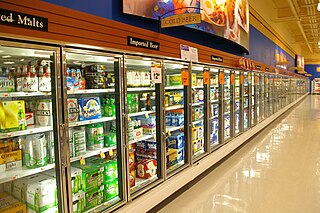
The term refrigeration denotes cooling of a space, substance or system to lower and/or maintain its temperature below the ambient one. Refrigeration is considered an artificial, or human-made, cooling method.

A railroad car, railcar, railway wagon, railway carriage, railway truck, railwagon, railcarriage or railtruck, also called a train car, train wagon, train carriage or train truck, is a vehicle used for the carrying of cargo or passengers on a rail transport system. Such cars, when coupled together and hauled by one or more locomotives, form a train. Alternatively, some passenger cars are self-propelled in which case they may be either single railcars or make up multiple units.
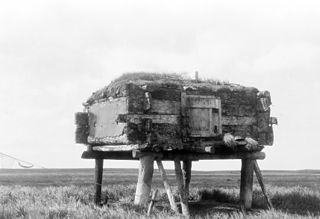
Food storage is a way of decreasing the variability of the food supply in the face of natural, inevitable variability. It allows food to be eaten for some time after harvest rather than solely immediately. It is both a traditional domestic skill and, in the form of food logistics, an important industrial and commercial activity. Food preservation, storage, and transport, including timely delivery to consumers, are important to food security, especially for the majority of people throughout the world who rely on others to produce their food.

The International Union of Railways is an international rail transport industry body.

In railroad terminology, a stock car or cattle car is a type of rolling stock used for carrying livestock to market. A traditional stock car resembles a boxcar with louvered instead of solid car sides for the purpose of providing ventilation; stock cars can be single-level for large animals such as cattle or horses, or they can have two or three levels for smaller animals such as sheep, pigs, and poultry. Specialized types of stock cars have been built to haul live fish and shellfish and circus animals such as camels and elephants. Until the 1880s, when the Mather Stock Car Company and others introduced "more humane" stock cars, death rates could be quite high as the animals were hauled over long distances. Improved technology and faster shipping times have greatly reduced deaths.

A refrigerator, colloquially fridge, is a commercial and home appliance consisting of a thermally insulated compartment and a heat pump that transfers heat from its inside to its external environment so that its inside is cooled to a temperature below the room temperature. Refrigeration is an essential food storage technique around the world. The lower temperature lowers the reproduction rate of bacteria, so the refrigerator reduces the rate of spoilage. A refrigerator maintains a temperature a few degrees above the freezing point of water. The optimal temperature range for perishable food storage is 3 to 5 °C. A similar device that maintains a temperature below the freezing point of water is called a freezer. The refrigerator replaced the icebox, which had been a common household appliance for almost a century and a half. The United States Food and Drug Administration recommends that the refrigerator be kept at or below 4 °C (40 °F) and that the freezer be regulated at −18 °C (0 °F).
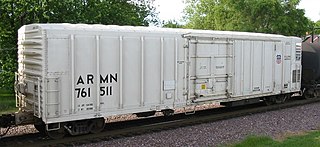
A refrigerator car is a refrigerated boxcar (U.S.), a piece of railroad rolling stock designed to carry perishable freight at specific temperatures. Refrigerator cars differ from simple insulated boxcars and ventilated boxcars, neither of which are fitted with cooling apparatus. Reefers can be ice-cooled, come equipped with any one of a variety of mechanical refrigeration systems, or utilize carbon dioxide as a cooling agent. Milk cars may or may not include a cooling system, but are equipped with high-speed trucks and other modifications that allow them to travel with passenger trains.

A tank car is a type of railroad car or rolling stock designed to transport liquid and gaseous commodities.

Gustavus Franklin Swift, Sr. was an American business executive. He founded a meat-packing empire in the Midwest during the late 19th century, over which he presided until his death. He is credited with the development of the first practical ice-cooled railroad car, which allowed his company to ship dressed meats to all parts of the country and abroad, ushering in the "era of cheap beef." Swift pioneered the use of animal by-products for the manufacture of soap, glue, fertilizer, various types of sundries, and even medical products.

Rail freight transport is the use of railroads and trains to transport cargo as opposed to human passengers.
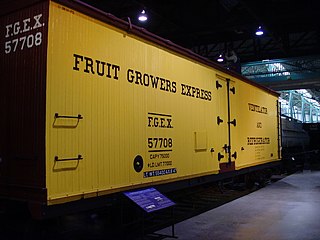
Fruit Growers Express (FGE) was a railroad refrigerator car leasing company that began as a produce-hauling subsidiary of Armour and Company's private refrigerator car line. Armour controlled both the packing operations and the transport insulated railroad car line, and its customers had complained they were overcharged. In 1919 the Federal Trade Commission ordered the company's spinoff of Fruit Growers Express for antitrust reasons, which was accomplished by 1920.

An icemaker, ice generator, or ice machine may refer to either a consumer device for making ice, found inside a home freezer; a stand-alone appliance for making ice, or an industrial machine for making ice on a large scale. The term "ice machine" usually refers to the stand-alone appliance.
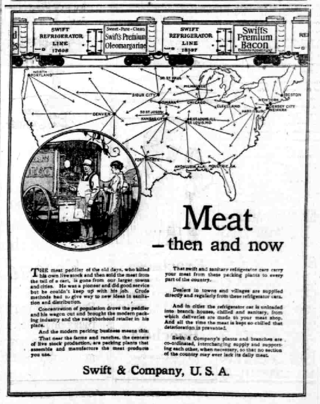
The Swift Refrigerator Line was a private refrigerator car line established around 1875 by Chicago meat packer Gustavus Swift, the founder of Swift and Company.

A refrigerated container or reefer is an intermodal container used in intermodal freight transport that is capable of refrigeration for the transportation of temperature-sensitive, perishable cargo such as fruits, vegetables, meat, and other similar items.

A refrigerator truck or chiller lorry, is a van or truck designed to carry perishable freight at low temperatures. Most long-distance refrigerated transport by truck is done in articulated trucks pulling refrigerated semi-trailers. Sometimes they are used to carry dead human beings.

Goods wagons or freight wagons, also known as goods carriages, goods trucks, freight carriages or freight trucks, are unpowered railway vehicles that are used for the transportation of cargo. A variety of wagon types are in use to handle different types of goods, but all goods wagons in a regional network typically have standardized couplers and other fittings, such as hoses for air brakes, allowing different wagon types to be assembled into trains. For tracking and identification purposes, goods wagons are generally assigned a unique identifier, typically a UIC wagon number, or in North America, a company reporting mark plus a company specific serial number.
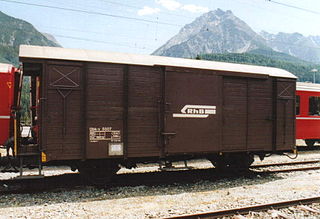
A covered goods wagon or van is a railway goods wagon which is designed for the transportation of moisture-susceptible goods and therefore fully enclosed by sides and a fixed roof. They are often referred to simply as covered wagons, and this is the term used by the International Union of Railways (UIC). Since the introduction of the international classification for goods wagons by the UIC in the 1960s a distinction has been drawn between ordinary and special covered wagons. Other types of wagon, such as refrigerated vans and goods wagons with opening roofs, are closely related to covered wagons from a design point of view. Similar freight cars in North America are called boxcars.
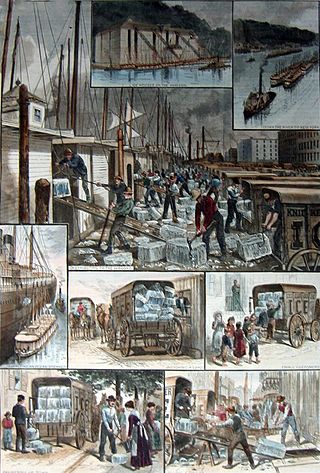
The ice trade, also known as the frozen water trade, was a 19th-century and early-20th-century industry, centering on the east coast of the United States and Norway, involving the large-scale harvesting, transport and sale of natural ice, and later the making and sale of artificial ice, for domestic consumption and commercial purposes. Ice was cut from the surface of ponds and streams, then stored in ice houses, before being sent on by ship, barge or railroad to its final destination around the world. Networks of ice wagons were typically used to distribute the product to the final domestic and smaller commercial customers. The ice trade revolutionised the U.S. meat, vegetable and fruit industries, enabled significant growth in the fishing industry, and encouraged the introduction of a range of new drinks and foods. It only flourished in the time between the development of reliable transportation and the development of widespread mechanical refrigeration.
The Victorian Railways used a variety of air-cooled and iced wagons or refrigerated vans for the transport of all manner of goods. This page covers the history and development of the various classes, and how they changed through their lives.